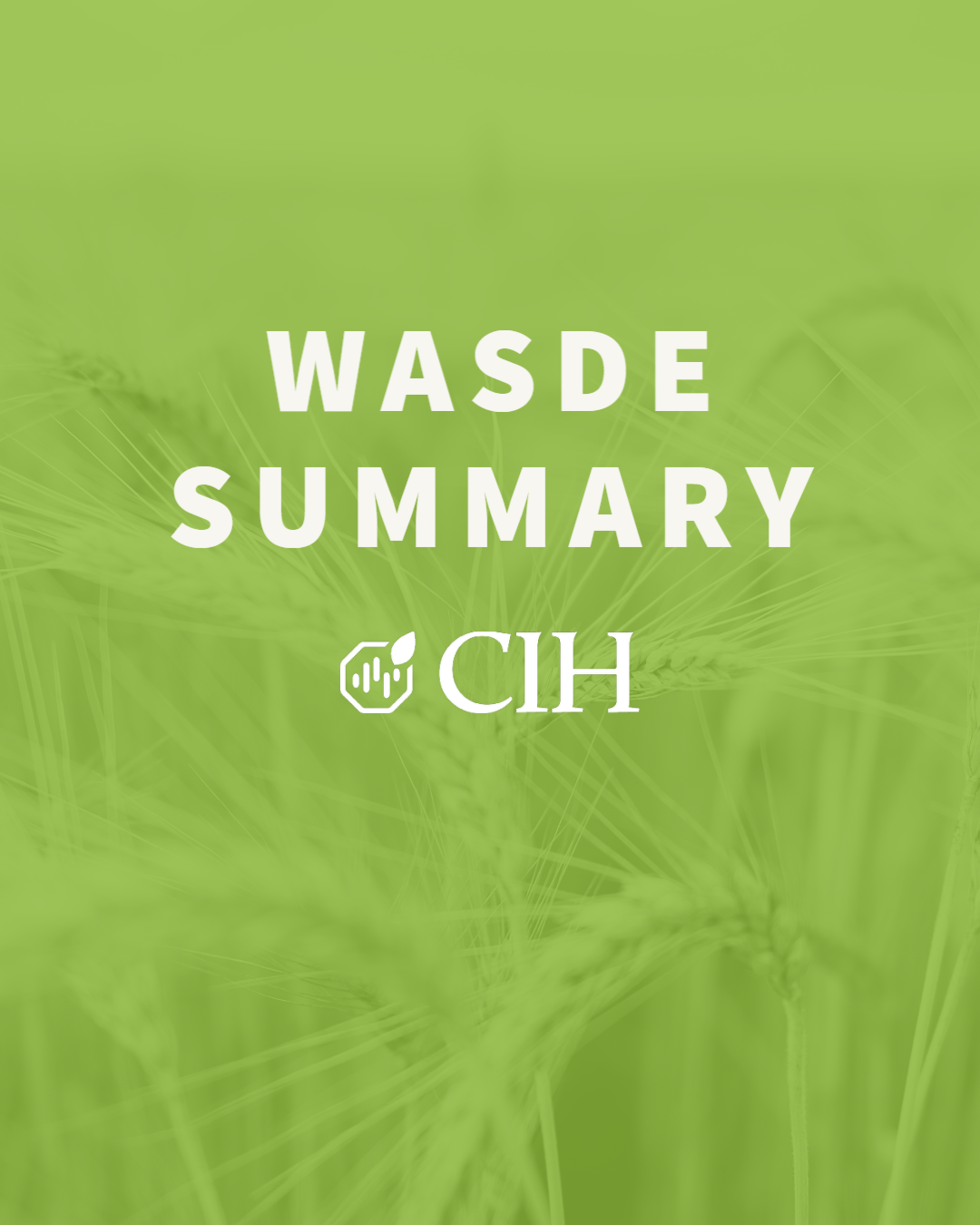
July 11, 2025
Today’s report was largely in line with analysts’ pre-report estimates and incorporated last month’s Acreage and Grain Stocks estimates into its balance sheets. Market attention will continue to focus on developing U.S. trade relations and weather’s impact on yield potential across the U.S. Midwest.
Corn
For corn, the domestic 2025/26 balance sheet called for smaller supplies, use, and ending stocks. Beginning stocks were cut 25 million bushels to 1.3 billion as an increase in old crop exports outweighed a reduction in old crop feed and residual use. New crop corn production was lowered 115 million bushels on lower planted and harvested area in last month’s Acreage report. As expected, yield was unchanged at 181.0 bushels per acre. Total production, at 15.705 billion bushels, was slightly below the average pre-report estimate of 15.748 billion bushels but within the range of estimates (15.624 to 15.953 billion range). Total use was lowered on a reduction in feed and residual use. Ending stocks were lowered 90 million bushels to 1.660 billion. This was below the analysts’ average pre-report estimate of 1.733 billion bushels and toward the lower end of the range of estimates (1.630 to 1.856 billion range). Brazilian corn production was increased on a boost in yield for the second crop harvest. Foreign corn ending stocks were cut, including reductions for China and India. Pegged at 272.1 million metric tons, global ending stocks were below the range of analysts’ pre-report estimates (275 to 280 million range).
Corn conditions have counter seasonally increased to their highest rating at this point in the year since 2018:

Major exporter stocks-to-use ratio expected to remain historically low:

Soybeans
For soybeans, the domestic 2025/26 balance sheet called for lower production, higher crush, reduced exports, and higher ending stocks. Soybean production was pegged at 4.335 billion bushels, nearly identical to analysts’ average pre-report estimate of 4.331 billion bushels. Yield was left unchanged at 52.5 bushels per acre, as expected. Crush was raised by 50 million bushels.
Today’s report included more commentary on regulatory impacts to the commodity markets than it typically does. The report stated “This month’s report assumes the U.S. Environmental Protection Agency’s (EPA) proposed rule for required Renewable Fuel Standard volumes for 2026 and 2027 when evaluating soybean oil demand. EPA not only significantly raised the mandates but also proposed to reduce the number of Renewable Identification Numbers (RINs) generated for imported renewable fuels and renewable fuels produced from foreign feedstocks starting in 2026, which increases demand for domestically produced feedstocks like soybean oil.” Regarding soybean oil, the commentary also noted “Along with EPA’s proposed rule, the forecast considered additional policy incentives like the 45Z Clean Fuel Production Tax Credit and current state mandates. As a result, soybean oil used for biofuel for 2025/26 is raised 1.6 billion pounds to 15.5 billion, reflecting a 23 percent increase from the prior 3-year average.”
New crop soybean exports were lowered from last month by 70 million bushels. As a result, new crop ending stocks increased to 310 million bushels. While this was above the analysts’ average pre-report estimate of 304 million bushels, it was within the range of estimates (275 to 377 million range). Global soybean supplies were increased and ending stocks increased, as well. Brazilian production was increased to 175 million metric tons, higher than CONAB’s estimate and above the average trade estimate. Global ending stocks were increased to 126.07 million metric tons, slightly above the upper range of analysts’ pre-report estimates (124.3 to 126.0 million range).
Domestic crush raised from last month:

New crop soybean exports lowered from last month as demand remains weak for this point in the year:

Brazilian soybean crop expected to be record large again:

Wheat
For wheat, the domestic 2025/26 balance sheet called for increased supplies, higher exports, and lower ending stocks. Supplies were increased on an 8 million bushel increase in production on higher yields. The all wheat yield was increased by 1.0 bushels per acre from last month. Pegged at 1.929 billion bushels, production was slightly higher than analysts’ average pre-report estimate of 1.903 billion bushels (1.846 to 1.956 billion range). Spring wheat production is less than last year at 504 million bushels on lower harvested area and yields and Durum was also lower on reduced yields. Exports were increased by 25 million bushels based on a strong early pace of sales and shipments. Domestic ending stocks were lowered by 8 million bushels to 890 million, nearly identical to analysts’ average pre-report estimate of 893 million bushels (842 to 923 million range). The global balance sheet called for reduced supplies and reduced ending stocks. Supplies were lowered on lower production for Canada, Ukraine, and Iran. Projected global ending stocks were lowered by 1.2 million metric tons to 261.5 million. This was lower than analysts’ average pre-report estimate of 264.7 million metric tons but within the range of estimates (260.7 to 276.0 million range).
Spring wheat production lowered on lower yields as crop conditions are historically weak in Montana and Washington:

All wheat production increased from last month, expected to remain below last year’s levels:

Major exporter ending stocks expected to fall for 3rd straight year:
